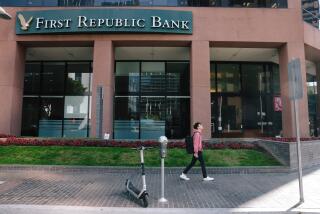Cost of Thrift Bailout Is Hiked to $160 Billion : S&Ls;: The Administration plans to ask Congress for billions of dollars more in additional funds, surpassing even the estimates of some critics.
- Share via
WASHINGTON — The Bush Administration has dramatically raised its estimate for the cost of the savings and loan bailout to as much as $160 billion, Treasury Secretary Nicholas F. Brady acknowledged Monday.
Brady said the Administration will ask Congress next week for billions of dollars more for the Resolution Trust Corp., the agency charged with handling the S&L; cleanup. Brady’s comment marks the first time that the Administration has admitted that the cost of the bailout will be higher than the $130-billion maximum it has projected for the past two years.
The estimate also exceeds that of some critics of the RTC’s operations. Just last week, the General Accounting Office estimated that the agency would need at least $150 billion to deal with the S&L; mess. The estimates include only current outlays and do not include interest, which could push the cost to as much as $500 billion in the next 40 years.
Brady’s pessimistic figures on the S&L; bailout assume that it will be necessary for the federal government to seize a total of 1,000 thrift institutions, roughly 600 more than have already been shut down, merged or sold on government orders.
Those numbers indicate that, with hundreds of S&L; failures still to come, the overburdened RTC will be inundated with billions of dollars in mortgages, real estate and securities to sell off into depressed markets for years to come.
Although Brady refused to say exactly how much money the Administration will request next week, the GAO said Monday that $50 billion will be “the minimum necessary funding” for fiscal 1992. Congress has already appropriated $80 billion for the thrift cleanup since 1989.
But the $50 billion represents the minimum just for the coming year, Richard L. Fogel, assistant comptroller general, said at a hearing Monday of the RTC oversight task force of the House Banking Committee. If the RTC tries to dispose of all of the troubled thrifts in the nation, “its funding needs will be much higher.”
In addition, more money will almost certainly be required next year, bringing the total to the $160 billion mentioned by Brady--or possibly even higher.
The official estimates of the costs of the taxpayer bailout of the S&L; debacle have continually escalated since Congress first passed S&L; bailout legislation in August, 1989.
The costs have proved to be a rapidly moving target because of both the real estate slump and what critics charge is slipshod management and sales efforts with seized properties by the RTC. On Monday, Fogel said the RTC is in such financial disarray that the GAO will be unable to provide an official audit of the agency by the June 30 deadline.
“We expect that our report to Congress will say the values shown in the financial statements (of the RTC) are uncertain and subject to significant change, the amount of which cannot be reasonably estimated,” Fogel said.
Rep. Bruce Vento (D-Minn.), chairman of the RTC task force in the House, agreed that the RTC seems to be unable to come to grips with the thrift crisis. “I have been frustrated over how long it has taken to implement practices that common sense would say would be fundamental to a program of the size of this one,” he said.
Brady defended the RTC, arguing that the agency has done a reasonably good job given the enormity of the task. Created in 1989 specifically to deal with the S&L; crisis, the RTC now has assets seized from S&Ls; of $162 billion, including 45,000 pieces of real estate with paper value of $18.4 billion.
“They have gone in about 18 months or so from having no employees to being bigger than Citicorp,” said Brady. “Am I satisfied with the S&L; bailout? No. But I think they have done a reasonable job given the circumstances.”
Brady also opened a last-minute campaign for the Administration’s banking reform legislation on Monday, suggesting that a taxpayer bailout for the nation’s banks can still be avoided if Congress agrees to overhaul federal banking laws this year.
Brady, meeting with reporters two days before the House Banking Committee is scheduled to begin considering banking reform, said a comprehensive banking reform bill can be passed by the House before the congressional summer recess in August.
“If we have a reasonable economic recovery, and a strong, comprehensive reform of the banking industry, then I think we have a strong, strong likelihood that we can avoid a taxpayer bailout,” Brady said.
Meanwhile, L. William Seidman, chairman of the Federal Deposit Insurance Corp., increased his official estimate of how many banks are likely to fail over the next two years.
Seidman, whose independent agency manages the deposit insurance fund, said that as many as 440 banks are likely to fail between now and the end of 1992, costing the deposit fund as much as $23 billion. Earlier, Seidman had projected only another 340 bank failures by the end of 1992, costing $15 billion.
More to Read
Get the L.A. Times Politics newsletter
Deeply reported insights into legislation, politics and policy from Sacramento, Washington and beyond. In your inbox twice per week.
You may occasionally receive promotional content from the Los Angeles Times.










